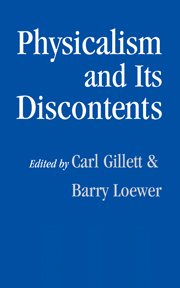Book contents
- Frontmatter
- Contents
- Contributors
- Preface
- Part I Physicalism
- Part II Physicalist Discontents
- Part III Physicalism and Consciousness: A Continuing Dialectic
- 13 Mental Causation and Consciousness: The Two Mind-Body Problems for the Physicalist
- 14 How Not to Solve the Mind-Body Problem
- 15 Deconstructing New Wave Materialism
- 16 In Defense of New Wave Materialism: A Response to Horgan and Tienson
- 17 Physicalism Unfalsified: Chalmers's Inconclusive Conceivability Argument
- References
- Index
14 - How Not to Solve the Mind-Body Problem
Published online by Cambridge University Press: 02 November 2009
- Frontmatter
- Contents
- Contributors
- Preface
- Part I Physicalism
- Part II Physicalist Discontents
- Part III Physicalism and Consciousness: A Continuing Dialectic
- 13 Mental Causation and Consciousness: The Two Mind-Body Problems for the Physicalist
- 14 How Not to Solve the Mind-Body Problem
- 15 Deconstructing New Wave Materialism
- 16 In Defense of New Wave Materialism: A Response to Horgan and Tienson
- 17 Physicalism Unfalsified: Chalmers's Inconclusive Conceivability Argument
- References
- Index
Summary
The conclusion I aim to establish in this chapter is this: the solution to the mind-body problem cannot take the form of an empirical identity statement but must rather consist in an analytic identity statement. That is, to solve the problem we would need to provide a conceptual reduction of consciousness, not an a posteriori reduction. It is not that I know what this conceptual reduction would look like – far from it. My thesis is merely that there is a general argument that shows that the solution must take this form. I shall also be concerned to spell out the consequences of this thesis for the prospects of solving the mind-body problem, and to indicate how my conclusion bears upon certain arguments that have been given to undermine physicalism.
The logical analysis of identity statements has proved crucial in assessing the claims of physicalism, and so it will be in this chapter. Early identity theorists, notably J.J.C. Smart, observed that not all true identity statements are conceptual truths, following Frege's precedent. This opened the way to claiming that there might be true identity statements linking mental and physical properties that could not be certified to be true on conceptual grounds alone. It was thus not incumbent on a physicalist to provide any analysis of mental concepts in order to claim to possess a complete physical reduction of mental properties. This liberalization of the conditions of adequacy upon a physicalist theory brightened the prospects for that theory considerably, and it established a paradigm for what a solution to the mind-body problem might look like. We could say that pain is C-fiber stimulation in the same spirit in which we say that heat is molecular motion.
- Type
- Chapter
- Information
- Physicalism and its Discontents , pp. 284 - 306Publisher: Cambridge University PressPrint publication year: 2001
- 5
- Cited by



